Siberian Proleska
Content:

What the Siberian Proleska looks like: a photo of a flowerbut
Siberian Scilla (Scilla siberica) is a very small plant with small drooping flowers. The advantage of this plant over other small bulbs is that it naturalizes well on lawns, more than others. A plantation of 10 small bulbs will produce a 1 m2 carpet in a few years. After all, a carpet of beautiful but tiny purple and blue flowers can cover the entire lawn. Therefore, it is not surprising that hobby gardeners try to benefit from the use of these simple yet highly valuable seedlings, especially at certain times of the year and in special situations when the garden is too bare.
Siberian Proleska flower: description of the plant
Each bulb of Proleski sibirskaya has only two to four basal, linear-elliptical, semi-closed leaves in a gray-green, bluish color and one or two oblique stems about 15 cm high, each decorated with two to five hanging blue star flowers. They have fruits in the form of small berries containing seeds with good germination.
It is a perennial herbaceous bulbous plant of the hyacinth family. Siberian Proleska, despite its name, is not from Siberia, but from the south-west of Russia, the Caucasus and Turkey. It is possible that he got his name because of his great resistance to "Siberian colds". Reaches 15-35cm in height. Bloom from March to April.
One of the advantages of Siberian bluebill is that it grows almost anywhere, adapting to direct sun and fairly dense shade, rich, poor soils, acidic and alkaline soils, and dry places. And in moderately humid areas.
In fact, the only situation in which the plant does not feel well is in truly damp soil, because like almost all bulbs, Siberian blueberry loves to dry out a little in summer.

What the Siberian Proleska looks like: a photo of a flowerbut
On lawns and flower beds, where an automatic irrigation system is used, the flower will not be happy. It tolerates cold well, but does not tolerate night frosts.
The Proleski genus includes about 100 species of plants, differing in the size of bulbs, leaves and color of flowers, which are widespread especially in Europe, China, Iran and Algeria.
Among the most common and very simple species for growing in pots or in the open field, Siberian wormwood Purple nail... It is a small bulbous plant with spear-shaped leaves, on the blades of which there are various spots of reddish-brown color. This plant is about 15cm tall and is suitable for growing in open sun, loose and dry soils, as it is drought tolerant.
Growing and care
Water when the soil is completely dry and moderate. In winter, if the temperature drops around 0 C, it should be stored indoors and in a sunny place.
Siberian redwood reproduces mainly by seeds. After flowering, seed capsules form on the peduncle, which ripen quickly and soon release the seeds into the soil, where they germinate next spring. Small plants can bloom for more than three years.
Prefers versatile soil, mixed with river sand and well-drained, rich in organic matter.
Composting. Siberian stalk is rustic plants that do not need regular fertilization, but in the spring and autumn, at least once, it is recommended to give a special fertilizer for flowering plants diluted in irrigation water, or a slow-release granular fertilizer distributed directly on the ground.
The most suitable fertilizer for producing more abundant flowering and flowers with a more intense color tone will be a fertilizer rich in phosphorus, which must be applied every 30 days during the vegetative cycle of the plant in spring-summer.
Growing in pots. Siberian sprouts are very easy to grow in pots on the balcony.The vase must be at least 20 cm high and twice as wide in order to plant at least 15 bulbs for impressive flowering. The soil must be of good quality and mixed with drainage material.
Potted plant bulbs of Proleski Siberian can be left in pots in places protected from winter frost under hedges or tree tops.
Reproduction occurs by dividing the bulbs in the fall and sowing in the spring. The bulbs are similar to tulip bulbs, from which they differ only in small size.
Transplant should only be carried out when roots are emerging from the drainage holes or when the bulbs occupy all the available space.
The new space should be several centimeters larger than the previous one. The soil should be fresh, fresh and rich in organic matter.
To facilitate the drainage of the water used for irrigation and to prevent root rot, we recommend placing the drainage material at the bottom of the pot.
Diseases and pests.
The flowers of Sibirica are very hardy, rustic plants and, as a rule, do not suffer from parasites such as aphids and scaly insects.
Among fungal diseases, the Siberian Proleska flower is sensitive to root rot if the soil for cultivation is not well drained.




